The
Story of D-Day and Omaha Beach
|

The Situation
Leading up to D-Day
|
The Atlantic Wall
In the days leading up to
D-Day, the Germans knew full well the Allies were
coming. The Atlantic Wall was an extensive
system of coastal fortifications built by Nazi
Germany between 1942 and 1944.
It ranged
along the western coast of Europe as a defense
against the anticipated Allied invasion of the
mainland continent from Great Britain.
Early in 1944, Field Marshal Erwin Rommel,
the famed "Desert Fox" from his days as commander in
Africa, was assigned to improve the Wall's
defenses.
Rommel
believed the existing coastal fortifications were
entirely inadequate. He immediately began
strengthening them. Under his direction, a string of
reinforced concrete pillboxes was built along the
beaches, or sometimes slightly inland, to house
machine guns, antitank guns and light artillery.
Mines and antitank obstacles were planted on the
beaches themselves and underwater obstacles and
mines were placed in waters just off shore.
The
intent was to destroy the Allied landing craft
before they could unload.
By the time of the invasion, the Germans had laid
almost six million mines in northern France.
More gun
emplacements and minefields extended inland, along
roads leading away from the beaches.
In likely
landing spots for gliders and parachutists, the
Germans emplaced slanted poles with sharpened tops,
which the troops called Rommelspargel ("Rommel's
asparagus").
Low-lying river basins and
delta areas were permanently
flooded as well.
Rommel firmly believed that Germany would inevitably
be defeated unless the invasion could be stopped at
the beach.
He was
determined not to let the Allies get the
slightest foothold on the European continent.
|
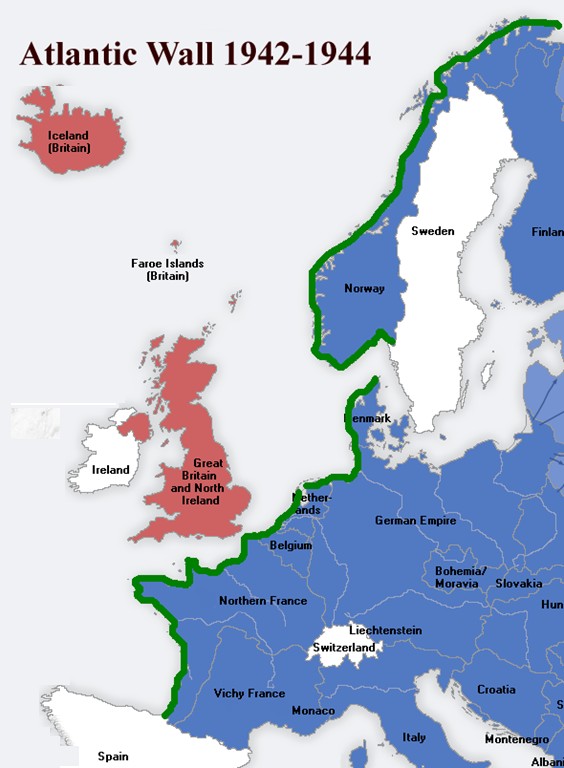 |
|
The two big questions in the mind of the
Germans were when and
where would the British,
Canadians and Americans strike?
Amazingly, the
Allies pretty much fooled the Germans on both questions.
Through a series of well-planned diversions, the Germans
were pretty sure that Calais, just 25 miles away from Dover,
was the target. Normandy was an afterthought.
By taking a
huge risk, Eisenhower also succeeded in fooling the Germans as to
when. In June 1944, a huge storm had been
raging along the English Channel all week long. Now another
huge storm was on its way. Eisenhower was told there was a
narrow window between storms if he wanted to gamble on June
6. On D-Day, the weather conditions were still terrible,
but not impossible. To say 'no' meant
being forced to wait another month. What if the secret
of the location leaked out? Eisenhower gave the
go-ahead.
For the most
part his gamble paid off. The Germans were taken completely
by surprise. For example, Erwin Rommel, the genius behind the formidable
Atlantic defenses, had taken the day off to celebrate his
wife’s birthday back in Germany.
In
addition, none of the German senior officers were
anywhere near the point of attack. The Germans were so convinced the Allies wouldn't
attack due to the weather that many
commanders took the weekend off
to meet for war games. Unable to see first-hand
what was going on, most of them dismissed the early signs of
paratrooper landings near Normandy as nothing more than deception tactics.
After all, wasn't the invasion supposed
to take place in Calais?
One of the
remarkable features of D-Day was just how successful the
Allies were at duping the Germans into believing the main
thrust would come at Calais.
The
flat-footed response on the part of the German officers
throughout the day prevented any possible chance of the
much-feared Panzer counter-attack.
Even after the
assault on Normandy began, much of the German high command
still believed this attack was just a fake to divert forces
away from Calais.
Field Marshall von Rundstedt screamed at his Nazi superiors
to allow him to move the vaunted Panzer divisions at his
disposal down to Normandy, but he was not permitted to
commit the armored reserve for several hours.
Apparently Herr Hitler's permission
was needed, but unfortunately Der Führer had taken a
sleeping pill and was not to be disturbed. This
screw-up cost the Nazis their best chance to repel the
Invasion. When the tanks
were
finally released late in the day,
it was much
much much
too late.
|
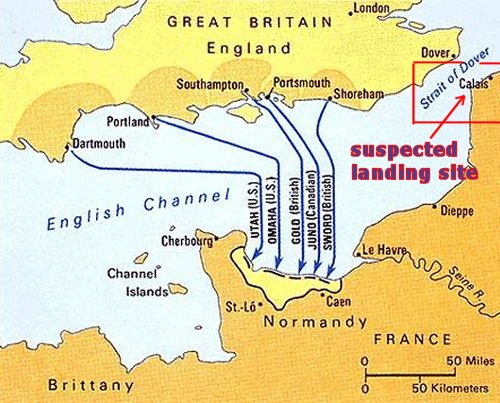
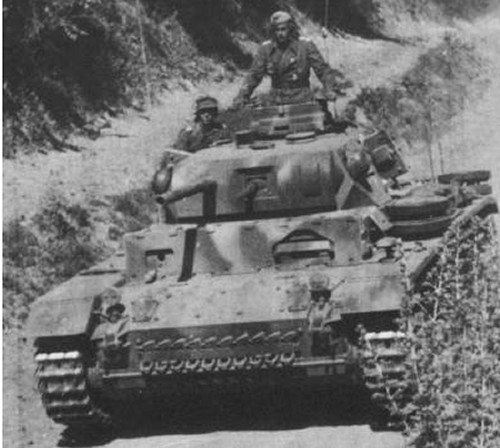 |
Unfortunately, the rough seas did end up costing many lives during the
landing. Unable to control the
landing boats due to wind and waves, at the Omaha Beach sector of Normandy
many boats landed far off course. This
caused tremendous disorganization and the initial attack was
a fiasco. Furthermore, the rough seas deprived the men the use of any
tanks during the horrible first landing at Omaha.
Without the much-needed protection of the tanks, the men
were at the mercy of the deadly machine gun fire.
Losing the tanks at sea in the storm crippled the initial
attack and cost many lives.
In
some ways, the Germans were right - who in their right mind
would dream of invading under these conditions?
|
| |
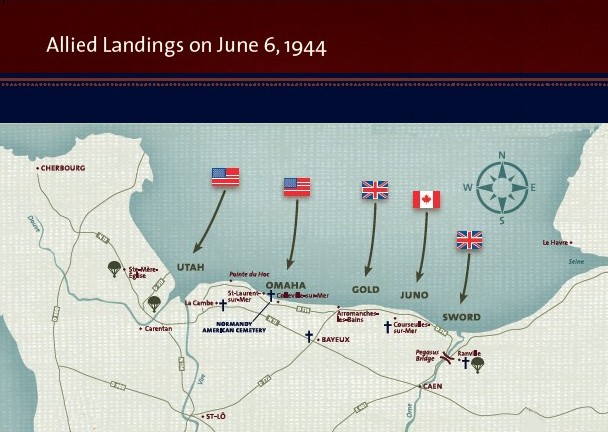 |
Why was
Normandy Chosen?
The Allies were
well aware there were too many miles
along the Atlantic seaboard for the Germans to defend every possible
landing point with sufficient manpower.
The Allies knew there would
be no such place as an undefended landing point, but if they could
at least identify a poorly defended spot, that would be a huge
advantage.
A highly
unsuccessful raid conducted by English against the French
port of Dieppe in 1942 had shown Allies how difficult it
would be to take a port intact using a direct attack.
Furthermore, the German defenses at Calais, the most logical
target, were overwhelmingly powerful.
With that in mind, in the time leading up to D-Day, the Allies did
everything in their power to divert German attention to places
they didn’t want to land such as Calais and
simultaneously conceal the location of their
eventual target in Normandy.
|
|
Why Normandy? One
of the finest natural ports in France could be found at Cherbourg on
the Cotentin Peninsula 20 miles west of the Normandy beaches.
If the Allies could take Cherbourg, a deep water port, then American supplies and
troops would have a direct pipeline to the European continent.
However Normandy was no easy target.
A simple glance at any map of the English
Channel reveals that Normandy was at best the fourth or fifth most
convenient target after Calais, Dieppe, and Le
Havre. Furthermore, Rommel was no fool. He suspected
Normandy would be the eventual landing site all along because that
is the spot he himself would have chosen. Unfortunately
for Rommel, the German High
Command refused to take his warnings seriously.
After
all, they had plenty of evidence that Calais was the target...
Why waste valuable resources on Normandy?
A
clever trick by the Allies had the Germans convinced the attack
would actually take place in Calais about 160 miles to the north of
Normandy. An attack on Calais made perfect sense. After all,
Calais and England were separated by only 25 miles of water.
Conversely Normandy was 100 miles from the nearest point on England,
making it a far less attractive landing point. The
perpetual rough seas of
the English Channel downgraded distant Normandy to only a remote
possibility.
The Allies went to great lengths to convince the Germans that Calais
was their destination. For example, they constructed a massive
airfield right across the English Channel from Calais and filled it
with thousands of airplanes… all constructed out of wood and painted
steel gray. There were dummy trucks and dummy
tanks too.
Fortunately, no German spy was able to get close enough to
decipher the trick. Aerial reconnaissance photos only showed a
gigantic military buildup directly across the water from Calais.
The Germans took the bait and concentrated the bulk of their forces
to the north at Calais. Furthermore the
Panzer reinforcement tanks were stationed nearby.
As it turned out, the
deception was invaluable. The placement of the Panzers near
Calais worked greatly to the Allied advantage. On D-Day the
tanks were much too far away to ever reach Normandy in time to be
used effectively.
|
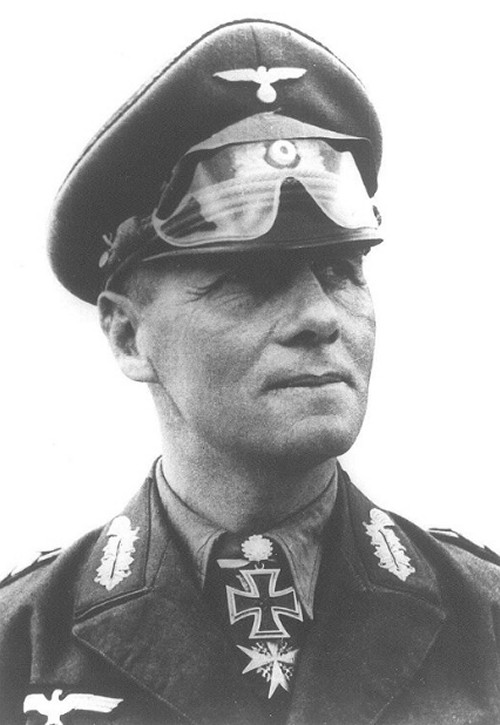
Erwin Rommel
|
George Patton as Decoy
There is a great deal of circumstantial evidence to suggest that the
Allies involved George Patton in their Calais deception as well.
The Allies had confirmed intelligence that the Germans believed
Patton would be leading the Allied assault into Nazi-held territory.
That made sense because Patton was the most
gifted fighter of all the Generals. Patton was an unbelievably
aggressive leader. He took bold and quite dangerous chances,
but they always seemed to pay off.
However Patton was not
particularly good at politics. Not only did Patton get along
very poorly with his superior officers, he lost his temper one day
during the invasion of Sicily. He slapped a soldier in a hospital
because he suspected the man was a
malingerer. Patton verbally abused the helpless man. Thanks to dozens of witnesses,
there was no way to cover up Patton's temper tantrum. Patton was
not only severely reprimanded, he was relieved of his command.
Calling it a "furlough", Eisenhower had a clever idea.
Since Patton was the general that the German High Command believed
would lead the attack, Eisenhower conveniently
used Patton's
"furlough" as a
trick to mislead the Germans as to where the next attack would be.
Patton was paraded around England as the
man of the hour.
|
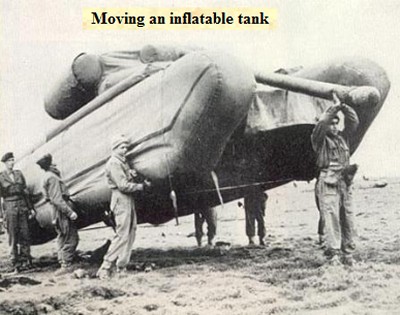
From the air, this
tank looked quite real
|
In the months before the June 1944 Normandy invasion, Patton gave
public talks as commander of the fictional First U.S. Army Group,
supposedly intending to invade France by way of Calais.
This was part of a sophisticated Allied campaign of military
disinformation, Operation Fortitude.
In a story recounted by Professor Richard Holmes,
an incident took place just three days
before D-Day. During a reception in the London Ritz Hotel, Patton
shouted across a crowded room in the direction of paratroop
commander General Jim Gavin, "I'll see you in the Pas De Calais,
Gavin!", much to the consternation of all those around him.
Patton's comment was a startling breach of secrecy...
except that it was a ploy. Everyone who was cringing was
simply playing their part in the deception. They were selling
the lie to anyone watching.
The ploy appears to have worked. Reports of overnight troop
movements north from Normandy were detected by Bletchley Park code
decrypts. Thanks in large part to their
"Calais" distraction, the Allies succeeded in fooling
the Germans as to where.
|
|
|
|
On the other hand, the Americans were badly misinformed themselves. The Americans had been told by the French Resistance
that the Normandy sector was seriously undermanned. According to
the French Resistance, Normandy was being defended half by Germans
and half by Polish prisoners forced to fight for the Germans at
gunpoint. How hard would it be to defeat
defenders who hated the Germans?
Furthermore, the men were told that a gigantic bombing campaign on
the part of the air force and navy on the morning of the D-Day would
devastate the German defenses.
So how tough could
Normandy be? They had the surprise of the weather on their side,
they had the surprise of the location on their side, they had an
undermanned target to attack, and a brutal bombing campaign would do
the rest. The men were told that they would meet little
resistance. Patton suggested that at
most 1 man in 50 would die. In some places, they might even be able to walk on the
beach without a problem.
|
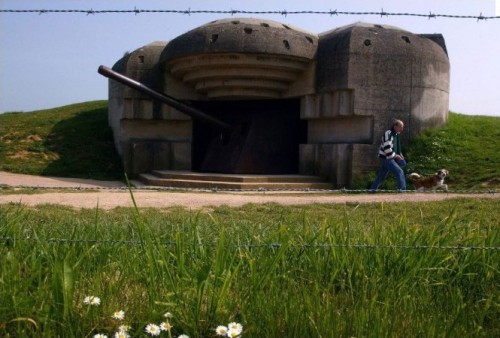 |
|
Unfortunately, no one walked on the beach
in the early part of D-Day without being shot at.
However,
Patton almost turned out to be right. At four of the five sectors where the Allies landed,
Patton's prediction of little to mild resistance
did prove correct. For
example, at Utah Beach just 20 miles west of Omaha Beach, the
battle was over in just an hour with light casualties
(200 men).
|
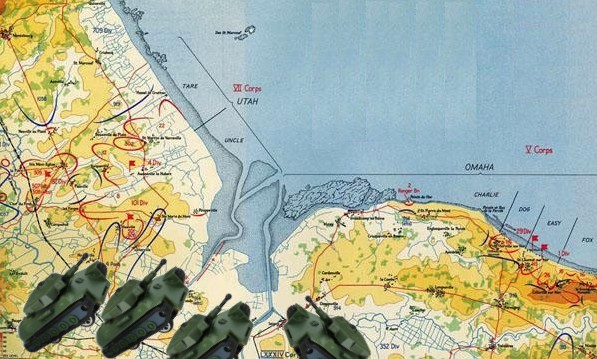
The Americans
knew full well that German strategy called for tank reinforcements
to decimate vulnerable soldiers on the beach using a fearsome
counter-attack. The fear was overwhelming.
|
The only place Patton was wrong was at Bloody Omaha Beach. And
boy was he wrong there.
The Allies knew in advance that Omaha Beach could be a
real problem. It
was the largest beach and
most easily defended of the five
attacked. Omaha had to be seized because
the 9 mile gap between Utah and Omaha
Beach (see picture) would have been too
wide to hold in case of the likely German
counter-offensive. In addition, Gold Beach
on the other side of Omaha Beach would also be vulnerable to Panzer counter-attack.
The Allies feared the counter-attack almost as much as they did the
initial defense. During the day’s fighting, they knew every
available German tank unit in the vicinity would be called
upon to meet the
threat.
If Omaha wasn't captured, a counter-attack by the
vaunted German
Panzer division coming through the Utah-Omaha gap could easily ruin the
entire invasion. The Allies were very worried about falling into another German
beach trap
similar to Dunkirk. The nightmare of seeing 330,000
troops trapped on the beaches of Dunkirk absolutely haunted the
strategists. Could this horror happen again at Normandy?
|
There were two schools of thought in the German High Command. The
strategy preferred by Field Marshal Erwin Rommel was
to prevent the
Allies from getting even the slightest foothold.
Keep them out at sea; murder the enemy on the beach.
The strategy preferred by Field Marshal Gerd Von Rundstedt was to
make it hard for the enemy to land and then to blow them back into
the sea when they were the most vulnerable. He
knew the German problem was available manpower.
The Russian Front had created a huge manpower shortage at the Atlantic
Wall. Von
Rundstedt argued that they didn't have enough manpower to guard every
possible landing point, but they did have the ability to quickly move
crack backup units to any point of attack. Why not overwhelm the
defenseless invading force as they sat counting their dead on the beach?
Omaha Beach had to be
taken to prevent the feared Panzer counter-attack.
|
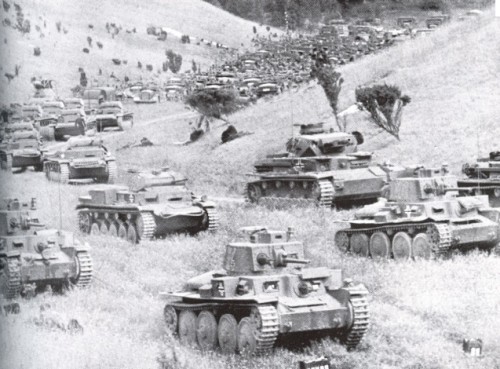 |
|
|
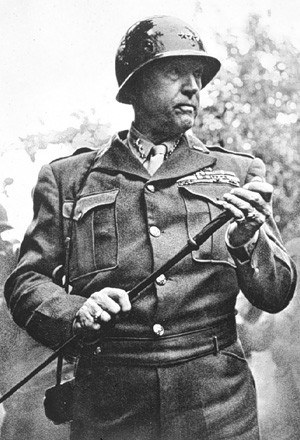 |
General George Patton made
a famous D-day speech on June 5th, 1944.
"You men are not all going to die. Only two
percent of you here today will die in a major battle. Death must
not be feared. Every man is frightened at first in battle. If he
says he isn't, he's a goddamn liar. Some men are cowards, yes!
But they fight just the same, or get the hell shamed out of them
watching men who do fight who are just as scared. The real hero
is the man who fights even though he is scared. Some men get
over their fright in a minute under fire, some take an hour. For
some it takes days. But the real man never lets the fear of
death overpower his honor, his sense of duty to this country and
his innate manhood."
There is one great thing you men will all be able to
say when you go home. You may thank God for it. Thank God, that
thirty years from now, when you are sitting around the
fireside with your grandson on your knees, and he asks you what
you did in the Great War, you won't have to cough and say, and
'I shoveled shit in Louisiana.' No, Sir, you can look him
straight in the eye and say, 'Son, your Granddaddy rode with the
Great Third Army and a Son-of-a-Goddamned-Bitch named George
Patton!"
Note:
As we all know, Omaha Beach became a
slaughter of the worst magnitude. Over 2,000
Americans died at Omaha Beach on D-Day out of 7,800 who
participated in the initial assault. That rounds out to 26%,
not 2%.
Patton wasn't much of a statistician, but that was one heck of a
speech nonetheless. He was quite a leader.
|
|
Why Did 2,000
Men Die at Omaha Beach?
|
This is a
picture of the German Widerstandsnester (WN), the defensive strong
points used to protect the gaps ('draws') between the hills. The Germans
were determined not to let American tanks get through.
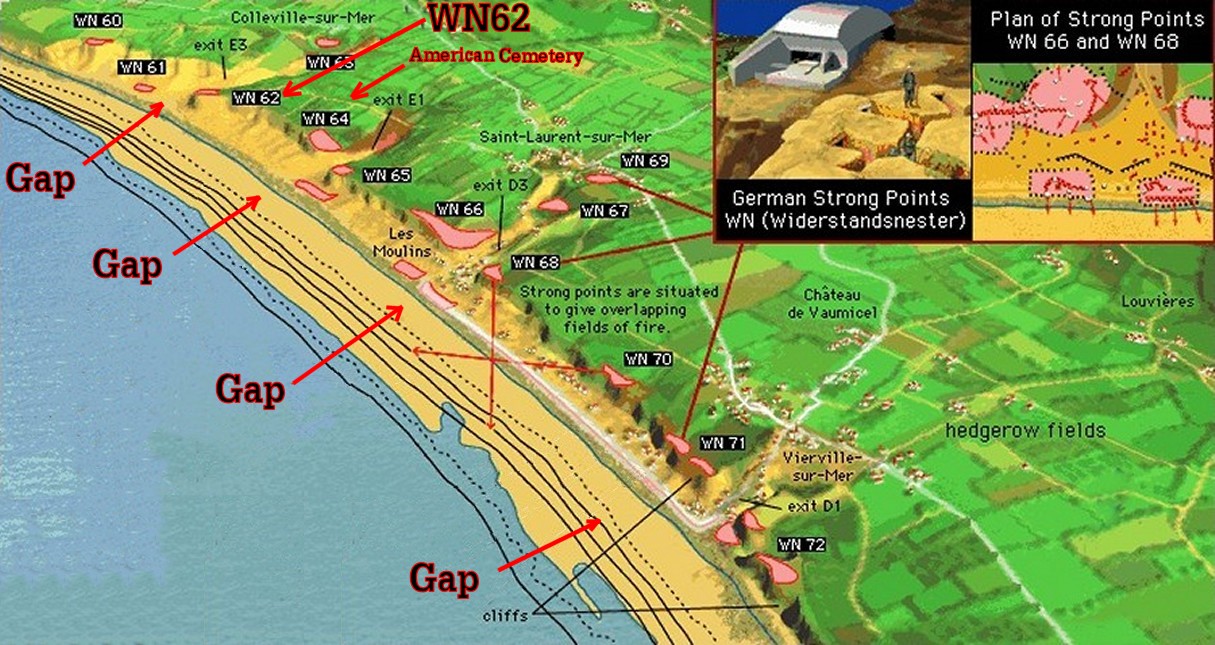 |
The
German Defensive Strategy
In order to truly
understand the battle of Omaha Beach, please study the map
above.
|
The 10 mile long beach had hills, bluffs and cliffs overlooking it.
No tank could cross these hills. The only way the tanks could
function was to break through one of the four gaps in the hills.
The entire defensive strategy of the Germans revolved around
defending those gaps. There were four important gaps
(aka 'draws') between the hills.
Each gap was named for
the nearest town behind it. There was Colleville
(E-3), Les Moulins (D-3), Vierville (D-1), and St Laurent
(Ruquet Valley) (E-1).
Even if a tank were to land on the beach, the roads through these
narrow valleys were the only way American tanks could possibly penetrate
into the French countryside. Rommel decided that was his
biggest nightmare, so he placed a strongpoint on both sides of each
gap.
In constructing his "Atlantic Wall", Rommel
had one serious handicap... he
had more land to cover than he had men. Consequently Rommel did not spread
out his men evenly, but rather concentrated them in strongholds
named "WiderstandsNester".
These "Resistance
Nests" were designed mainly to protect the roads that would
allow Allied tanks inland. Studying the picture above, you
will see red areas marked with
WN62,
WN71,
etc. Those "WN"s were the German strong points.
|
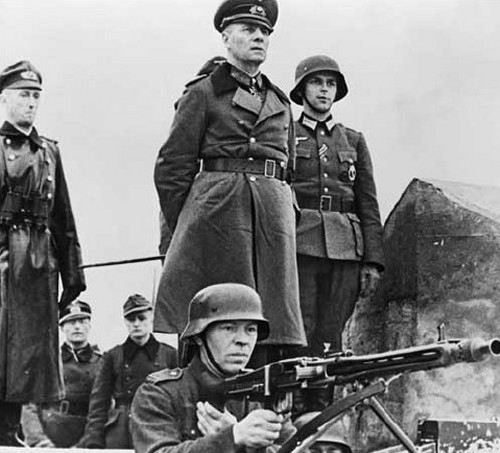 |
Rommel didn't have
enough tanks to devote to every single likely invasion point.
So he developed an
ingenious solution. Rommel had a crack
Panzer "counter-attack" division at his disposal.
It was this overwhelming force that struck fear into the heart of
every D-Day strategist.
Rommel cleverly stationed this unit at the
France/Belgium border, a midway point of sorts. Like a fast
free safety in football who rotates to the ball wherever it is
thrown, wherever the Allies landed - be it Calais, Le Havre, Brest, Dunkirk,
or Normandy - the Panzer tanks could be there
in a matter of hours to reinforce the defense.... on one condition!
The German defense
absolutely could not let the Allied tanks break out into the
countryside before
their Panzer tanks got to the invasion site.
Therefore, at Normandy,
guarding the "Gaps" was Rommel's main priority.
Rommel relied
on putting two strong points at every gap to give his Panzer
divisions enough time to rush to any spot where the Allied invasion took place. Rommel's strong points
were powerful indeed. The most famous strong point was WN62.
This strong point
bedeviled the Allied attack all morning long.
|
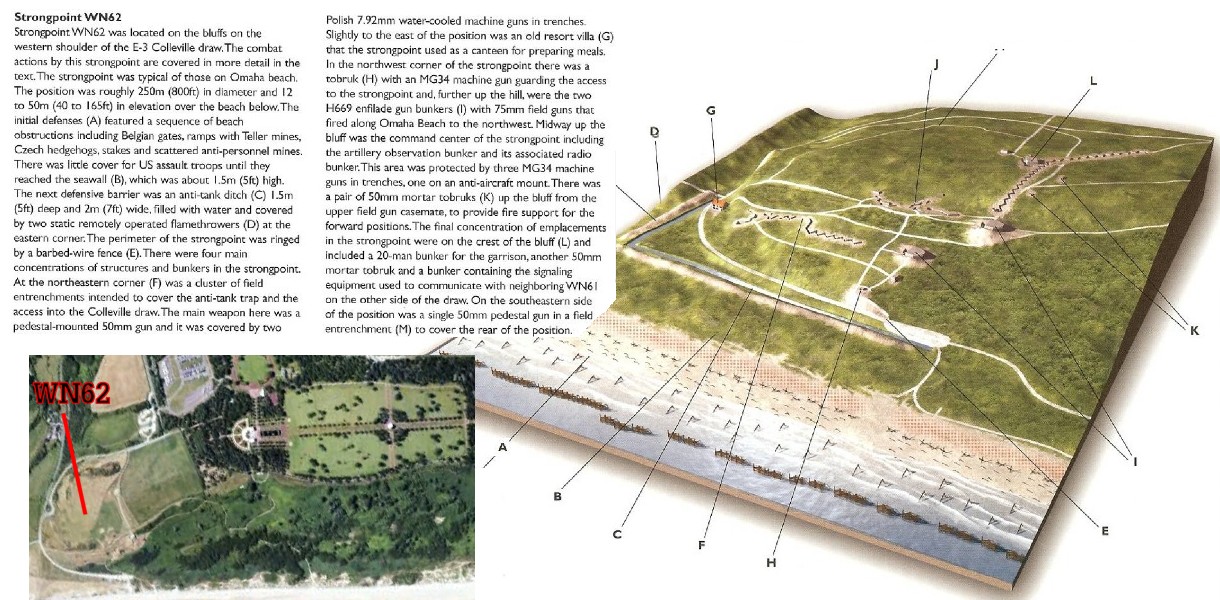 |
Strong point
WN62
was important for several reasons.
WN62
guarded an important GAP that led to a village known as
Colleville. Unlike the other three gaps which were easily
defended valleys, this particular gap was very wide and not steep at all.
Even if the road was destroyed, there were large fields that would
allow tanks far much too much freedom for Rommel's comfort.
This area was especially vulnerable. Accordingly, Rommel
made sure that
WN62
was made to be especially powerful.
Unfortunately the
Americans agreed with Rommel. They saw that "Exit E3" was unusually inviting. As a result, they made this
area a focal point of their attack and walked straight into a trap.
WN62
gained
notoriety on D-Day for killing more Americans than any other single
spot in the entire war! 1,000 men died here.
WN62
is located very close to the American Cemetery. The strong
point and the cemetery are only 600 yards apart. This
proximity is not a coincidence. So many men died at this spot
thanks to
WN62
that the first temporary cemetery was located nearby. The
temporary burial ground eventually became the permanent Memorial
site.
Today many of the German
WN62
fortifications are
still standing. Many
people who visit the Normandy Memorial eventually wander over to
inspect the huge concrete "casemates" (the German term for
'bunkers')
that are easily noticed from a distance. After marveling at
the thick bunkers, no one can leave the
WN62
area unimpressed. This area was quite formidable.
WN62
consisted of 8 concrete bunkers. There
were
two massive 75 mm cannons housed inside
concrete
casemates. These
giant casemates were half buried inside
the hill for protection. In addition to the cannons, there
were 35 pillboxes with machine guns or artillery, 18 anti-tank guns,
six mortar pits, 35 rocket launcher sites and 85 machine gun nests.
The strongpoint had large concrete
walls protruding to the seaward side at the front to protect them
from an attack directly from the front. In
addition, there were anti-tank ditches and mine fields around
the site. The site had many zig zag trenches which enabled the
defenders to move from one position to another with cover from
incoming fire. This was a powerful position indeed.
As you can see from
the picture on the right,
WN62
had a completely unobstructed view of the beach. The hill was
not very steep. As previously mentioned,
WN62
was credited with killing more men than any other strong point on
D-Day.
WN62
was home to the German D-Day superstar Heinrich Severloh, the
infamous
'Beast of Omaha'.
Severloh manned a
machine gun in a submerged foxhole at a spot quite likely somewhere
in that picture. He fired on the waves of approaching
American GIs with his machine gun and two Karabiner 98k rifles.
He relied on his comrades using trenches to maintain a continuous flow of
ammunition to him. While they re-armed his machine gun, he
would pick off more targets with the rifles. Not a moment was
wasted.
Starting at 6 am, by 3 pm, Severloh had
fired approximately 12,000 rounds with the machine gun and 400
rounds with the two rifles. Severloh was credited with
killing close to 1,000 men. Amazingly, Severloh claimed he killed even more than that!
If this is true, by himself this one man put down half the
Americans killed in action that day.
Severloh
even managed to escape unharmed. Seeing
WN62 was about to
fall, he used a trench to sneak off to a nearby
village. He was later caught as he escorted American prisoners
to a collection point. Since no one had any idea what Severloh had
done, he was treated just like any other German captive. It
wasn't till years later when he wrote his autobiography that Severloh received his notoriety.
He became an instant national hero. Severloh's story reflects just how
easy it was to kill the defenseless soldiers.
Unfortunately, Omaha Beach was the perfect
defensive situation for the Germans. It was a narrow enclosed
battlefield leaving no possible way to flank it because the
hills
surrounding the beach were virtually perpendicular to the ground.
The beach served as an open
killing field, there being no cover for the Allies until they
reached the sea wall which was 4 to 12 feet tall.
It is hard to believe, but the assault soldiers
had to cross 300 YARDS of open beach just to be able to reach that wall.
Can you even begin to imagine crossing the length of 3 football
fields under heavy machine gun fire?
In addition to the favorable terrain,
the Germans had thoroughly prepared for the attack. Rommel made
sure that every inch of the beach was covered by guns, mines and
explosives. Rommel had positioned twelve strong points along the
beach and throughout the seawall, each holding '88' cannons,
'75'
cannons, and mortars for the Allies to deal with. The Germans had
also set up dozens of machine gun pillboxes, supported by a
complicated trench system which wove throughout
the hillside.
There were also countless guns
positioned at different angles to have plunging fire, grazing fire, and
crossing fire from all types of weapons.
This made it even more
difficult for the soldiers to make their way to the base of the sea
wall, and then up the wall. General Rommel even went to the trouble
of protecting the larger weapons from Allied bombardment by building
sturdy concrete walls around them, then burying them under huge
mounds of earth. Some bunkers were so well
hidden that only a million to one shot had any hope of
damaging these powerful bunkers.
Furthermore, unbeknownst to the American, the
352, an elite German
unit, had been training at Omaha Beach for
the past month. Rather than go up against a defense unit watered
down with reluctant Polish prisoners, the Americans were walking
into a deadly trap defended by a premier unit of dedicated German
soldiers.
The addition of the
352
meant Omaha was the best defended stretch of beach on the entire coast of
Europe.
The Americans never
knew what hit them.
|
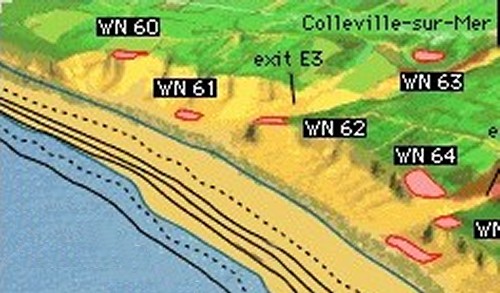
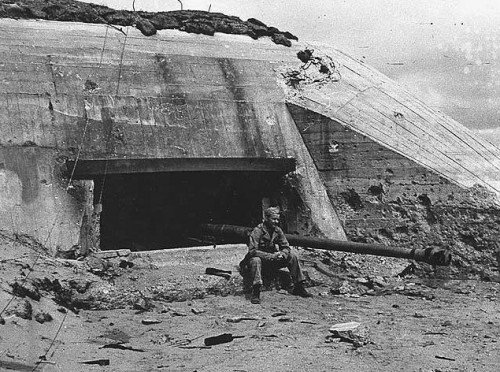
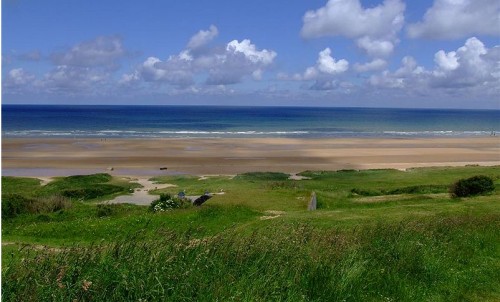
This is
outlook from Severloh's commanding position
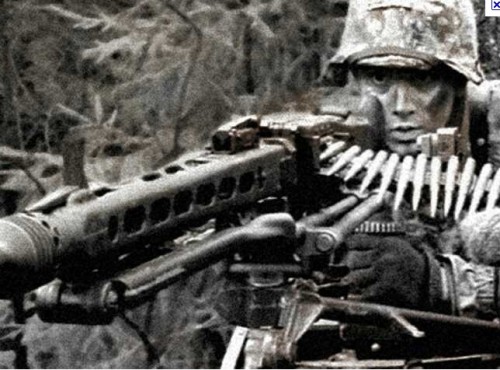
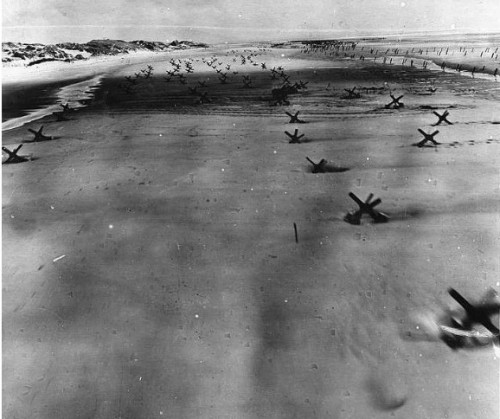
|
|
|
|
|
|
|
|